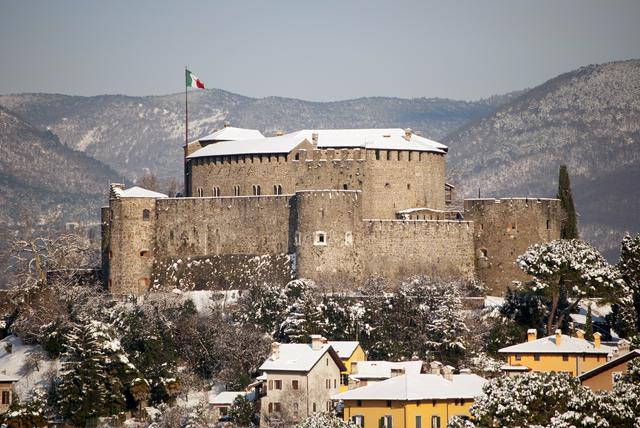Gorizia is a charming small city, right on the border with Slovenia.
At one time Gorizia was the main town of the surrounding region but has been separated since 1945 when the international border ran through the eastern part of the city. Today there is a new town, Nova Gorica across the border on the Slovenian side. Since 2007 the two cities have effectively rejoined when Slovenia joined the Schengen zone ending the need for passport controls between the two countries.
Surprisingly Slovene isn't spoken much in Gorizia (unlike the towns which surround Trieste). However across the border in Nova Gorica you'll find many people who speak Slovene, Italian and English.

- The Castle. Built within the Middle Ages walls, this was once the seat of the administrative and judiciary power of the county. It is divided into the Corte dei Lanzi (with foundings of a high tower demolished in the 16th century), the Palazzetto dei Conti (13th century) and the Palazzetto Veneto. The palatine chapel, entitled to Saint Bartholomew, houses canvases of the Venetian school of painting and traces of Renaissance frescoes. There is also a Museum of the Goritian Middle Ages.
- The Cathedral. Originally erected in the 14th century, like many of the city's buildings, it was almost entirely destroyed during World War I. It has been rebuilt following the forms of the 1682 edifice, a Baroque church with splendid stucco decoration. A Gothic chapel of San Acatius is annexed to the nave.
- Church of St. Ignatius of Loyola. The most important church of Gorizia, built by the Jesuits in 1680–1725. It has a single nave with precious sculptures at the altars of the side chapels. In the presbytery Christoph Tausch painted a Glory of St. Ignatius in 1721.
- Palazzo Attems Petzenstein. Designed by Nicolò Pacassi in the 19th century.
- San Rocco church.
- Palazzo Cobenzl. Current seat of the archbishops.
- Earls of Lantieri's house. This structure used to house emperors and popes.
- Palazzo Coronini Cronberg. Includes an art gallery.
- Transalpina railway square. Divided by an international border.
The Castle. Built within the Middle Ages walls, this was once the seat of the administrative and judiciary power of the county. It is divided into the Corte dei Lanzi (with foundings of a high tower demolished in the 16th century), the Palazzetto dei Conti (13th century) and the Palazzetto Veneto. The palatine chapel, entitled to Saint Bartholomew, houses canvases of the Venetian school of painting and traces of Renaissance frescoes. There is also a Museum of the Goritian Middle Ages.
The Cathedral. Originally erected in the 14th century, like many of the city's buildings, it was almost entirely destroyed during World War I. It has been rebuilt following the forms of the 1682 edifice, a Baroque church with splendid stucco decoration. A Gothic chapel of San Acatius is annexed to the nave.
Church of St. Ignatius of Loyola. The most important church of Gorizia, built by the Jesuits in 1680–1725. It has a single nave with precious sculptures at the altars of the side chapels. In the presbytery Christoph Tausch painted a Glory of St. Ignatius in 1721.
Palazzo Attems Petzenstein. Designed by Nicolò Pacassi in the 19th century.
San Rocco church.
Palazzo Cobenzl. Current seat of the archbishops.
Earls of Lantieri's house. This structure used to house emperors and popes.
Palazzo Coronini Cronberg. Includes an art gallery.
Transalpina railway square. Divided by an international border.
Walk across the international border to admire the stunning train station in Nova Gorica and have a gamble in one of the casinos in the Slovenian part. Generally Gorizia is the more beautiful city but it can feel like a graveyard especially in the afternoons and at weekends when shops are closed (as is common throughout Italy). Nova Gorica is much more lively and although the town itself isn't beautiful, its surrounding countryside, hills and rivers are especially so.
As with most Italian cities, shops tend to close for lunch and on Sundays (even though the neighbouring city's shops remain open, taking away their trade). Nova Gorica isn't a cheap city, but you will find that Slovene supermarkets have a greater variety of goods, and that alcohol and cigarettes are cheaper in the Slovenian city.
